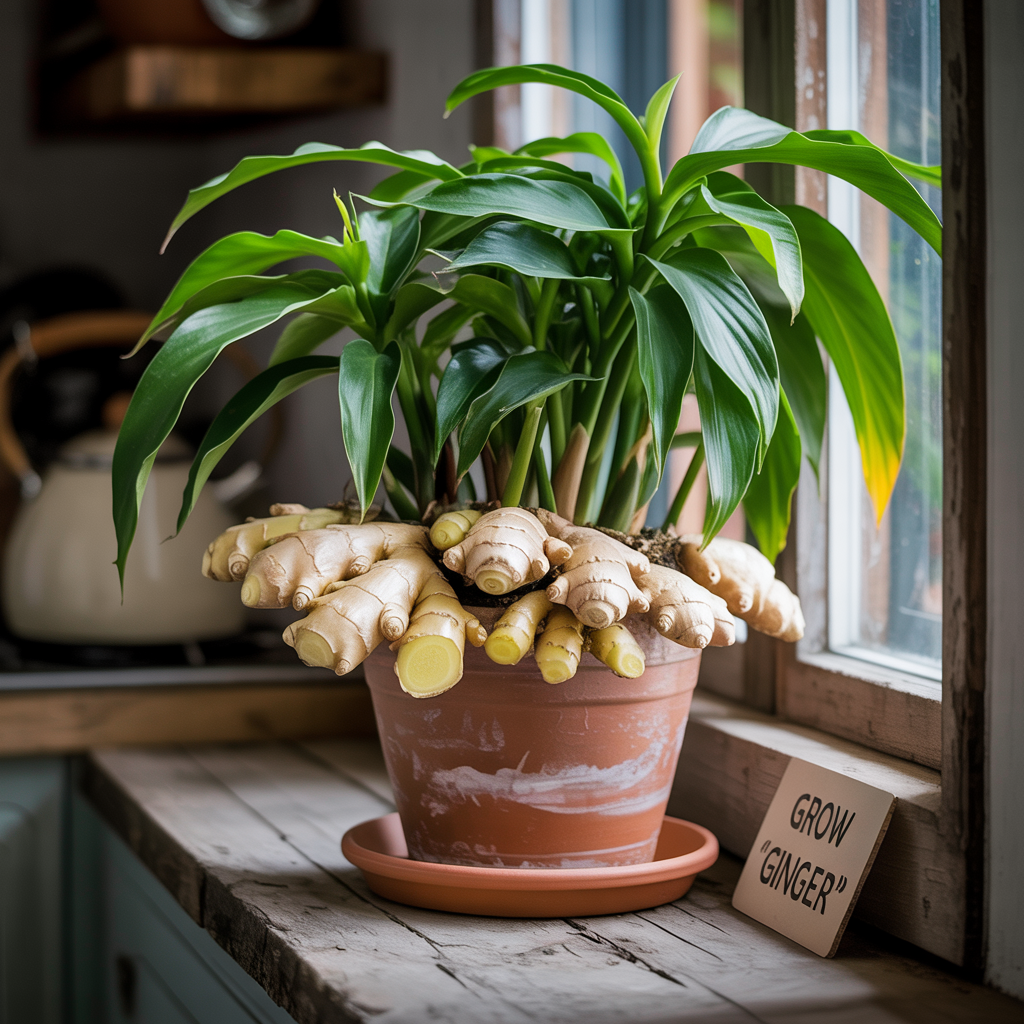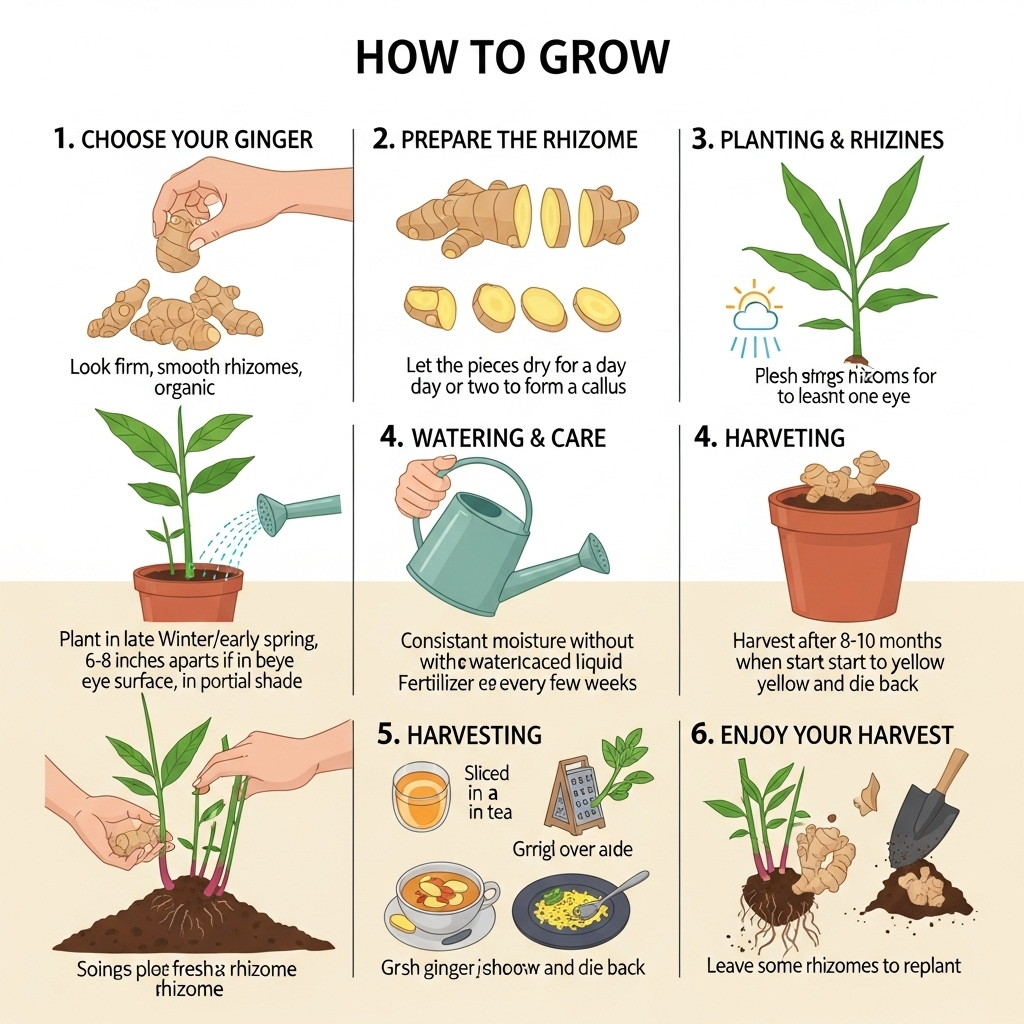Everything you desire in Office and Home

Fresh ginger has an amazing, zesty flavor. It adds a special kick to so many dishes. What if you could grow it yourself? It is easier than you might think. This guide shows you how to plant ginger. You can enjoy a fresh supply right from home.Buy Plants online sometimes don’t work
Growing your own food is very rewarding. You know exactly what goes into it. This is perfect for healthy, organic living. Let’s get started on your ginger-growing journey. We will cover every step from start to finish. You will be an expert in no time.
This complete guide makes it simple. We will show you how to choose a root. We will explain the best soil to use. You will learn everything needed to grow ginger at home. Get ready for a fun and delicious project.
Everything You Need to Know to Grow Ginger at Home
Growing ginger is a wonderful experience. It connects you with your food. You will learn about the plant’s life cycle. This process is great for beginners and kids. Our goal is to make it easy for you. Follow these steps for a successful harvest.

Choosing the Right Ginger Rhizome
Your journey starts at the store. You need to pick the perfect ginger root. This piece of ginger is called a rhizome. The right one gives you a great head start. A healthy rhizome leads to a healthy plant.
Look for a plump, firm piece of ginger. Avoid roots that are dry or shriveled. You want to see small bumps or “eyes.” These are the growth buds. New shoots will sprout from these eyes. More eyes mean more potential for plant growth.
You can often find good ginger at the grocery store. Look in the organic section. Organic ginger is less likely to be sprayed. Some non-organic ginger is treated to stop sprouting. For the best results in organic ginger farming, always start with an organic rhizome. A local farmers market is another great source.
Preparing Your Ginger for Planting
Once you have your ginger, it needs some prep. This step helps it sprout faster. It prepares the rhizome for its new home. It’s a simple but important part of the process.
First, you can soak the ginger. Place it in a bowl of warm water. Let it soak overnight. This helps wake up the rhizome. It signals that it is time to start growing. This is especially helpful if the ginger seems a bit dry.
Next, you can cut the rhizome into pieces. Make sure each piece is 1-2 inches long. Each piece must have at least one or two growth eyes. Use a clean, sharp knife for this. After cutting, let the pieces sit for a day. This allows the cut surface to dry and form a callus. This callus prevents the pieces from rotting in the soil.
The Perfect Pot and Soil
Ginger loves a comfortable home. The right pot and soil are very important. This is key when you plant ginger in pots. A good environment helps the roots grow strong. It provides the nutrients your plant needs.
Choosing Your Container
Ginger roots spread horizontally. This means you need a wide, shallow pot. A pot that is at least 12 inches wide is ideal. Good drainage is the most important factor. Make sure your pot has several drainage holes at the bottom. Trapped water will cause the rhizome to rot.
Here is a table to help you choose the right container size.
| Number of Ginger Pieces (1-2 inches each) | Recommended Minimum Pot Width | Recommended Minimum Pot Depth |
|---|---|---|
| 1-2 pieces | 12 inches (30 cm) | 8 inches (20 cm) |
| 3-4 pieces | 16 inches (40 cm) | 8 inches (20 cm) |
| 5+ pieces | 20+ inches (50+ cm) | 10 inches (25 cm) |
Creating the Ideal Soil Mix
Ginger needs soil that is rich and drains well. You can buy a high-quality potting mix. Or, you can make your own. A great mix is one part garden soil and one part well-rotted compost. You can also add perlite or sand to improve drainage.
Ginger prefers slightly acidic soil. The right pH helps the plant absorb nutrients. Aim for a soil pH between 5.5 and 6.5. You can buy a simple soil test kit. This helps you check your soil’s acidity level.
| Soil pH Level | Condition | Action Needed |
|---|---|---|
| Below 5.5 | Too Acidic | Add a little garden lime to raise pH. |
| 5.5 – 6.5 | Ideal Range | Perfect for growing healthy ginger. |
| Above 6.5 | Too Alkaline | Mix in compost or sulfur to lower pH. |
Step-by-Step Planting Guide
Now for the fun part! It is time to plant your ginger. This is a very exciting step. You are on your way to a fresh harvest. Follow these instructions on how to plant ginger for the best results.
- Fill your pot with your prepared soil mix. Leave about an inch of space at the top.
- Take your ginger pieces. Place them on top of the soil.
- Position them with the growth eyes facing up. This helps the shoots grow towards the sun.
- Space the pieces about 6-8 inches apart. This gives them room to spread.
- Cover the ginger with 1-2 inches of soil. Do not plant them too deep.
- Water the soil lightly. It should be moist, but not soggy.
Essential Ginger Plant Care Tips
Your ginger is now planted. Your job is not over yet. Proper care will ensure it grows big and strong. These ginger plant care tips are easy to follow. They will help you have a great harvest.
Watering Your Ginger Plant
Consistent watering is very important. Ginger likes moist soil, but hates wet feet. Overwatering is a common mistake. It can lead to root rot. Let the top inch of soil dry out between waterings. Then, water thoroughly until it drains from the bottom.
As the weather changes, your watering will change. You will water more in hot summer months. You will water less in the cooler fall.
| Season | Watering Frequency | Notes |
|---|---|---|
| Spring (after planting) | Every 3-4 days | Keep soil consistently moist to sprout. |
| Summer (active growth) | Every 2-3 days | Water more often in very hot weather. |
| Fall (growth slowing) | Every 5-7 days | Reduce watering as leaves start to yellow. |
| Winter (dormant) | Every 1-2 weeks | Water just enough to keep soil from drying out. |
Light and Temperature Needs
Ginger is a tropical plant. It thrives in warm and humid conditions. It prefers partial shade over direct, harsh sunlight. A spot with morning sun is perfect. It protects the plant from the hot afternoon sun.
Ginger plants do not like the cold. They stop growing when temperatures drop. Frost will kill the plant. If you live in a cold climate, bring your pot indoors for the winter.
| Factor | Optimal Range | Notes |
|---|---|---|
| Temperature | 70-85°F (21-29°C) | Growth slows below 60°F (15°C). |
| Light | Partial Shade / Filtered Sunlight | 2-5 hours of direct sun is enough. |
| Humidity | High | Mist the leaves occasionally to increase humidity. |
Feeding and Fertilizing
Ginger is a heavy feeder. It needs plenty of nutrients to grow. Start fertilizing about a month after you see growth. Use a balanced, all-purpose fertilizer. You can use a liquid fertilizer every few weeks. Follow the instructions on the package.
For organic ginger farming at home, use organic options. Compost tea is a fantastic choice. You can also mix in a slow-release organic fertilizer. A layer of compost on top of the soil also works well. It feeds the plant slowly over time.
Watching Your Ginger Grow
Patience is part of the process. It takes a few weeks for the first green shoots to appear. This is a very exciting moment. Soon, you will have beautiful, leafy stalks. They can grow up to four feet tall. They look a bit like bamboo.
The real magic is happening below the soil. The rhizome is growing and expanding. New “hands” of ginger are forming. It’s amazing to think about the harvest to come.
| Growth Stage | Approximate Timeline | What You’ll See |
|---|---|---|
| Sprouting | 2-4 weeks | Small green shoots poke through the soil. |
| Vegetative Growth | 2-5 months | Tall, leafy stalks grow. The plant gets bigger. |
| Rhizome Development | 5-8 months | The underground rhizome expands and matures. |
| Maturation / Dormancy | 8-10 months | Leaves start to yellow and die back. |
Harvesting Your Fresh Ginger
The time has finally come to harvest. This usually happens 8 to 10 months after planting. You will know it is ready when the leaves turn yellow. The stalks will start to fall over. This is a sign the plant is dormant.
You can harvest a small piece of “baby ginger” earlier. This is around 4-5 months. Baby ginger is tender and has a milder flavor. It does not need to be peeled. It is great for pickling or in salads.
To harvest mature ginger, gently dig up the entire plant. You can use a small hand trowel. Be careful not to bruise the rhizomes. Shake off the excess soil. You will see a large cluster of ginger. You can break off what you need. Save a piece with some growth eyes to replant for next year!
Frequently Asked Questions (Q&A)
Here are answers to some common questions. They will help you on your ginger growing journey.
Can I grow ginger from a store-bought root?
Yes, you absolutely can! This is the most common way people grow ginger at home. Choose a fresh, plump rhizome from the grocery store. Opt for an organic one if possible. It is less likely to have been treated with a growth inhibitor.
Why are my ginger plant’s leaves turning yellow?
Yellow leaves can mean a few different things. If it is late in the season, it is normal. The plant is going dormant and is ready for harvest. If it is early, it could be a sign of overwatering. It can also mean a lack of nutrients. Check your watering schedule and consider fertilizing.
How long does it take to grow a full ginger rhizome?
It takes about 8 to 10 months to grow a large, mature ginger rhizome. The process requires patience. But the reward of fresh, homegrown ginger is worth it. You can start harvesting small amounts of baby ginger in about half that time.
Your Ginger Adventure Awaits
You now know how to plant ginger. You have learned everything you need. From picking a root to harvesting your crop. It is a simple and enjoyable project. The taste of your own fresh ginger is unbeatable. It will make your meals taste even better.
Growing food connects us to the earth. It is a healthy and sustainable practice. You can do it even in a small space. All you need is a pot, some soil, and a little bit of care. These ginger plant care tips will guide you.You Can visit Premium to know more.
We encourage you to give it a try. Start your ginger-growing adventure today. It is a journey of patience and reward. We would love to hear about your experience. Share your ginger-growing stories in the comments below
